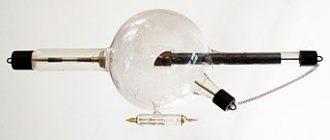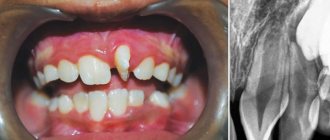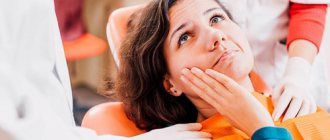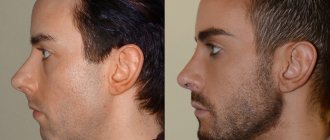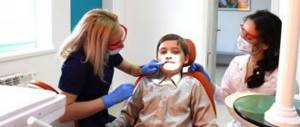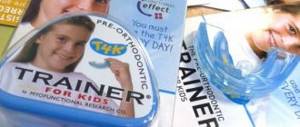6834
Orthodontic treatment does not always involve the use of special devices. In some situations, it is enough to use myogymnastics.
This option is an effective remedy for correcting abnormal bites , which has been proven by studies conducted over 50 years.
What it is?
The bite is formed due to the proper functioning of the muscles located in the area of the dentition and jaw joint. Any disturbance in their functioning leads to the formation of an abnormal position of the teeth and jaw arch.
The main goal of myotherapy is to restore the proper functioning of the joint and muscle system by influencing them using regular exercises, sometimes in combination with massage. At its core, myogymnastics is training the jaw muscles.
It is advisable to prescribe the technique as a comprehensive or independent treatment. It is also used to consolidate the effect after hardware orthodontic treatment or as a preparatory procedure before it.
Treatment principle
The principle of treatment of this technique is the complexity of the effect.
Under the influence of active motor exercises, improvement occurs due to four physiological mechanisms :
- Biological stimulation of bone tissue growth and muscle development.
- Formation of a compensating mechanism.
- Positive effect on trophic processes.
- Normalization of functional characteristics.
Under the influence of these processes, there is an active restructuring of muscle function and skeletal development towards anatomical balance.
Bottom line
Myogymnastics is an effective method for correcting dental anomalies. It can be used as an independent treatment, in combination with hardware treatment and as a prophylactic agent. Until the child’s baby teeth are replaced by permanent teeth, the issue of myotherapy needs to be resolved.
After a full course of gymnastic exercises, the chewing function is restored, the tone of the facial muscles is normalized, and the lower jaw becomes more mobile. In addition to restoring the functionality of the maxillofacial region, diction is corrected and articulation becomes clearer.
Remember that a set of exercises should be selected by an orthodontist based on the diagnosis of the child’s oral cavity. It is not recommended to work with your baby on your own.
Sources used:
- Anikienko, A.A. Hardware orthodontic treatment and its subordination to the physiological laws of irritation / A.A. Anikienko, N.V. Pankratova, L.S. Persin. — M.: Medical Information Agency
- Andreishchev, A.R. Combined dentofacial anomalies and deformities / A.R. Andreischev. — M.: GEOTAR-Media
- Kalamkarov, Kh. A. Orthopedic treatment of pathological abrasion of hard dental tissues / Kh.A. Kalamkarov. — M.: Medicine
Indications and contraindications
Indications for prescribing myogymnastics are:
- various types (distal, mesial, etc.) of degree I malocclusion;
- uneven placement of crowns;
- hypotonicity of the facial muscles;
- dysfunction of the TMJ (Rokabado myogymnastics);
- dysfunction of the circular muscles of the mouth and tongue.
Myotherapy cannot be used in a number of cases :
- pathological hypertrophy of the facial muscles;
- poor mobility of the jaw joint;
- abnormal bite III degree;
- disorders of jaw development due to previous common diseases, for example, rickets.
How can it be used?
Depending on the initial diagnosis, myotherapy can be prescribed as independent therapy or combined with other correction methods.
As a rule, complex bites require complex treatment, and along with gymnastics, hardware correction is used using removable or non-removable orthodontic devices.
For mild anomalies in early childhood, it may be sufficient to use exercises alone. Only if they are ineffective, hardware correction is performed after 2–3 months.
If gymnastics is prescribed to eliminate myofunctional habits, then special devices are often used to perform the exercises : a vestibular plate and a metal disk.
Who is it suitable for?
This technique is primarily aimed at treating children aged 4 to 8 years during the period of primary malocclusion. The jaw at this age is not fully formed and lends itself well to correction.
It is also permissible to carry out treatment with the help of exercises for children after 9 and up to 12 years , when active teeth change occurs. But the therapy in this case will be longer.
To correct the dentofacial apparatus in adulthood, myogymnastics is rarely used, since it gives minimal effect.
Causes of dental pathologies
Anomalies in the structure of the jaw and dental pathologies begin to form from birth. One of the reasons is the pacifier. However, abnormal formation of the jaw can also be caused by improper breathing through the mouth, as well as some bad habits. Thumb sucking is one of the persistent habits in children, which later leads to orthodontic pathologies.
Parents should pay special attention to forming the right habits in their child and weaning them from the wrong ones.
Breastfeeding forms the baby's correct bite by training the orbicularis oris muscle, tongue, and neck. Bottle feeding contributes to disruption of the maxillofacial muscles if the nipple has too large a hole.
The transfer to artificial feeding instead of breastfeeding may be due to reasons independent of the mother’s wishes. Therefore, carefully monitor the development of the baby’s jaw and show it to the dentist during the development. If the hole in the nipple is too wide, the baby gets full faster and stops sucking. Consequently, the muscles do not train and become weak.
Harm from pacifiers
How is a pacifier harmful to the formation of a bite? When sucking a pacifier, the tongue gets used to the incorrect position in the oral cavity. The tongue should be positioned on top of the nipple while sucking, but in babies everything happens the other way around. The lower position of the tongue (under the nipple) contributes to incorrect bite formation. In order not to spoil your baby’s bite, give him a pacifier as little as possible, and remove it from his mouth during sleep.
At the age of 1.5-2 years, the baby should be weaned off the pacifier so that the bite does not deteriorate.
Thumb sucking
Some babies try to replace the lack of a pacifier by sucking their thumb or the corner of a pillow. The child must be weaned from this habit immediately; it is even more harmful than sucking a pacifier. Sometimes the habit of falling asleep with your thumb in your mouth remains for life.
Thumb sucking leads to a very severe defect in the structure of the dental system, when the front teeth protrude forward and diverge to the sides. The bite is formed taking into account the position of the thumb between the lower and upper teeth, so there is an empty space. In addition to aesthetic dissonance, this arrangement of the frontal molars makes it impossible to bite food with the front teeth. Front teeth that are pushed forward are often susceptible to injury.
Mouth breathing
How can improper breathing affect the formation of the dental system? When breathing through the mouth, the pressure in the oral cavity that the cheeks exert on the upper row of teeth is disrupted. Because of this, the upper jaw arch narrows in size and the teeth grow crowded.
When should you pay attention to proper breathing? This must be done from the first days of the baby’s life and closely monitor his breathing while sleeping with a pacifier. As soon as the baby stops crying and falls asleep, the pacifier is immediately removed from the mouth. If you see that your baby has opened his mouth in a dream, carefully close it with your hand.
What to do if a child’s adenoids are enlarged and he cannot breathe through his nose? At this time, you need to make sure that mouth breathing does not become a habit. After healing from a runny nose and cold, you should monitor the child’s correct breathing during sleep and wakefulness. There is a special set of exercises to practice breathing through the nose after removal of the adenoids.
Lower lip suction
There is also a habit among children that subsequently negatively affects their appearance. Because of this bad habit, a gap is formed between the teeth, the size of which is equal to the thickness of the lower lip. Myogymnastics can correct an abnormal bite; hardware correction is also recommended.
Placing tongue between teeth
This bad habit leads to the formation of a gap between the upper and lower teeth. This gap corresponds to the size and shape of the tip of the tongue, which the child is accustomed to sticking forward. There is also a habit, invisible to adults, of placing the tongue between the chewing teeth (on the side). This pathology can only be noticed by a dentist.
As a result of incorrect position of the tongue in the oral cavity, the lateral molars sag and the bite is formed abnormally. The defect can be corrected with the help of functional devices and myogymnastics.
Improper swallowing
Doctors divide the swallowing function into conscious and uncontrolled. Correct swallowing should be noticeable only by the movement of the Adam's apple. If the facial muscles tense during swallowing, these are already symptoms of pathology. Improper swallowing leads to incorrect placement of molars in the dentition. If you notice that your child is swallowing food or drinking water in a special way, immediately take him to the orthodontist.
Advantages and disadvantages of the method
The main advantage of this technique is that the adjustment can be carried out without the use of orthodontic appliances. Thanks to this, the child does not experience psychological or physical discomfort.
This eliminates injury to mucous membranes and damage to dental tissue .
The disadvantages of myotherapy include:
- duration of treatment;
- low efficiency in relation to pronounced anomalies;
- in the absence of consistency, regression quickly occurs.
How to speed up results
Often, children with the same orthodontic disorders experience different dynamics in the quality of treatment. As experts note, this is not about the characteristics of the child’s body, but about the correctness of performing gymnastics and following all the doctor’s recommendations.
To increase the effectiveness of myogymnastics, parents need to remember the following basic rules:
- Increase the duration and intensity of muscle contractions gradually but regularly.
- Increase muscle contraction to the maximum.
- Do all exercises until fatigue appears.
- Maintain breaks between muscle contractions. The duration of such a pause should always be equal to the duration of the squeeze.
- Carry out gymnastics every day at the same time.
What does efficiency depend on?
To maximize the effect of exercise, you need to consider some factors :
- gymnastics must be carried out efficiently : contract muscles as much as possible and constantly increase the number of exercises;
- if possible use additional devices to increase the load on the muscular system;
- carry out systematically at the same time;
- a set of exercises should only be selected by an orthodontist .
After using myotherapy in patients of the same age with the same diagnosis, the result is often completely different. Most often this happens due to non-compliance with recommendations and lack of consistency.
Special devices
For the presented method, additional devices are sometimes used:
- Metal discs - their main purpose is to rid children of bad habits such as thumb sucking, as well as to correct distal occlusion and mouth breathing. The disc is clamped in the mouth, with the jaw slightly extended forward; for a certain time it is necessary to hold it in a horizontal position.
- Vestibular plate - This is used during sleep to ensure proper breathing and tongue position, as well as jaw position. Using a finger, it is inserted into the oral cavity, pulling out a special ring.
General rules
Regardless of which complex was shown to the patient, the exercises should be performed taking into account the general rules :
- Gymnastics begins with easy exercises and gradually moves on to more complex ones.
- When contracting, the muscles must move with the maximum permissible amplitude.
- When performing, it is necessary to gradually increase the speed of contractions. In this case, there should be a pause between them corresponding to the time of contraction.
- Exercises are carried out in accordance with the doctor’s instructions or until slight fatigue appears.
How myogymnastics is performed, watch the video:
Rogers technique
The first methodological developments for correcting orthodontic defects of the dental system were proposed by the American dentist A. Rogers. According to his recommendations, the exercises should be performed as follows:
- muscles should contract as widely as possible;
- the intensity of contractions should not exceed the natural load;
- exercises must be performed on a regular basis;
- movements should not be sharp or intermittent, but smooth and slow;
- exercises should be repeated until slight (local) fatigue appears;
- Myogymnastics can be done with children aged 4 years and older.
The rules that Alfred Rogers proposed to take as a basis are still relevant today. Based on these rules, modern orthodontists create their own sets of exercises for the correction of dentofacial pathologies.
Examples of exercises
A large number of exercises intended for myogymnastics have been identified. Each of them is indicated for certain pathologies or myofunctional disorders.
Gymnastics for oblique bite
If there is no symmetry in the contact of the two jaws only one exercise is used , which can partially or completely eliminate the problem.
The exercise is performed in a certain way: open the mouth as wide as possible and move the jaw to the side where there is no correct closure.
Then the jaw is slowly closed until the teeth are tightly clenched. And fix this position for at least 5 seconds.
After completion, completely relax the muscles and repeat the movement again.
Exercises for mesial overbite
The mesial type bite will help correct the following complex:
- In a sitting position, open your lips slightly and tilt your head slightly back. Closing your mouth, try to touch the tip of your tongue to the hard palate at the base.
- For 5 minutes, apply pressure with your tongue on the lingual surface of the anterior row of crowns.
- Place the lower lip under the anterior crowns of the upper jaw and fix it for half a minute.
Gymnastics for underdevelopment of the orbicularis oris muscle
This complex is a direct indication for oral breathing and pathological lip non-closure:
- The lips are pulled out and in this position they try to pronounce complex words for 30 seconds.
- They stretch out their lips, imitating blowing out a candle, and then smile broadly.
- When compressing your lips, take in air through your nose and inflate your cheeks as much as possible. After this, place your fists on your cheeks and squeeze the air out of your mouth with them so that your lips remain closed.
- Alternately draw in air, slightly inflating first the lower lip, then the upper lip. In this case, the lips should be tightly closed.
- Hold a strip of cardboard or a special interlabial disc with your lips tightly compressed. At first, you need to hold it for about 15 minutes or until fatigue appears, and then increase this time to one hour.
- Stretch the corners of your mouth with your fingers, and then fix the position and try to purse your lips.
- Place cotton wool rolls under your lips, and then try to pronounce the sounds “b”, “m”, “p”.
Myogymnastics for deep bite
To relieve this pathology, gymnastics is performed only while standing:
- Place your arms back behind your back and pull your chin up. Without changing the position, move the movable jaw forward as far as possible.
After waiting for a few seconds, gradually return it to the reverse position.To get the effect, it is recommended to repeat this exercise at least 10 times per session.
- In exactly the same position as in the first exercise, the jaw is pushed forward as much as possible until the cutting part of the incisors of opposite rows of teeth touches and held for up to 20 seconds.
This must be repeated 15 times in 3 approaches for a month.After 30 days, the exercise needs to be slightly modified, moving the jaw so that the lower row of teeth extends in front of the upper one.
- For 4 minutes, slowly open and then close your mouth completely. The jaw remains fixed. About 5 sessions are needed per day.
Gymnastics after trimming the frenulum of the tongue
Such a simple procedure as cutting the frenulum of the tongue also requires the use of gymnastics, which will train the muscular system that affects the development of the lower jaw:
- Run your tongue along the inside of the dentition, as if counting all the teeth in turn.
- Open your mouth and circle with your tongue, touching the outside of your lips. In this case, you must try to reach the chin and tip of the nose.
- Press your tongue forcefully first on one cheek and then on the other.
Exercises for the middle part of the tongue
The main group of exercises that restore the functions of the muscular system of the middle part of the tongue includes:
- Place two rubber rings on the middle and tip of the tongue. Then the teeth are closed, and the lips are slightly opened and the tip of the tongue is pressed against the surface of the palatine vault. The position is fixed for 3 minutes.
- Click your tongue at least 50 times. Repeat the exercise 6 times a day.
- Imitate yawning for 2 minutes.
Open bite exercises
To eliminate the problem of an open bite, the muscles on which the lifting of the lower jaw depends are trained:
- The essence of the exercise is to open and close the teeth until fatigue appears.
To understand which muscle group is working and control the strength of their contractions, you need to place your fingers on your cheeks in the area of the last molars. - Clenching the jaws through resistance.
Two fingers of the hand act as resistance, which are placed on the front crowns of the movable jaw. When lifting it, you must actively prevent movement. - Biting a pencil or stick with the front incisors. In order not to damage the enamel, it is advisable to put a rubber tube on the item being used. The exercise is performed with effort for at least 5 minutes.
Myogymnastics for correcting lip closure
To correct improper lip closure, there are a large number of exercises that can be easily performed by children:
- Extend your tongue and place it on the lower lip, while trying to quickly cover it with your upper lip, as if slapping it.
- When pressing your lips tightly, you need to move your tongue in a circle, alternately touching the upper and lower lips.
- The tip of the tongue is drawn longitudinally across the palate, gradually covering its entire surface.
- Opening your mouth as wide as possible, press your tongue to the roof of your mouth. Then, closing your lips, make a clicking sound, imitating the blow of a hammer.
- Pull your lips out with a tube, while holding the corners of your lips with your fingers.
Forecast
It is possible to get the first positive results with proper and regular gymnastics within 1.5-2 months. The effectiveness of this complex depends on:
- age;
- consistency and quality of execution;
- degree of development of pathology.
Gymnastics helps to achieve good results for children with mammary occlusion aged 4-7 years. At this time, their jaw muscles and the jaw itself are actively growing, and they “respond” well to the effects of this technique. It is noted that the older the child, the longer the gymnastics course will be.
With regular exercises, changes in muscle function, proper development of bone tissue are observed, the position of crooked teeth is restored, all trophic processes are improved, and the bite is gradually corrected.
For older children, it is recommended to perform it only as an additional method to the main orthodontic treatment. As an independent therapy, exercises are effective in the presence of abnormal development of the upper incisors.
Important: for adults with a mature dentofacial apparatus, correction of malocclusion using myogymnastics is not effective.
